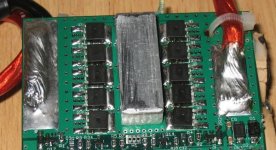I made a little video showing how to mount large banks of large FETs to heavy copper bus bars.
Requires all sorts of tricky tools and skills to use.
Or, maybe just 3 very simple tools.

Normal stove-top electric burner on your oven.
$4 jar of solder paste (yes, $4 shipped!)
Little flat steel plate, about 1/4" thick or so, and at least bigger than the FET layout by enough to leave handholds on each side. A little 6x10" 1/4" steel plate that costs about $2 would be fine (or aluminum scrap plate, or pretty much
Arrange the FETs however you like them, in the case of these slick IXYS fets, just screw them down to the heatsinks in the right positions etc, because the connection side is on the non-sinked side of the package (which is what makes them dominate all other SMT parts).
Set the little chunk of steel on the oven burner, and make sure it over-hangs enough to get a hand with a hot-pad on each side to lift it. Lay out your bus bars on the steel plate surface. A little tracing paper with the diagram layed out on the top of it and a bright light seems to work well if you've got a super elaborate layout to get all perfect, normally it's not too tough to just eyeball it, or have a few marks on the steel plate for alignment. If you're super fussy, you can kapton-tape down areas you're paranoid about sliding around magiclly or whatever.
Once it's all layed out, put a tiny-tiny little dab of solder paste on some of the pieces in some areas. These are just temp indicators to let you know the temp is right. If you have a little IR temp gun, that works fine too, but the little temp indicator bits of paste work very well, not critical to have the IR temp gun.
Set out a folded soaking wet towel on the counter next to the stove.
Apply the solder paste to the FET legs you wish to be connecting. For the IXYS fets, this means just bend the gate leg out of the way, and/or all ready have your 6 wires on them and bent up out of the way if your buss bar setup is going to be blocking access to them.
Turn on the burner, watch the indicator dabs of solder paste, when they've all melted, switch off the burner, watch your alignment marks, and set the FET/sink array down onto the bus bars. The solder paste melts and wets almost instantly on contact. Have those hotpads ready, and lift up the steel plate and set it down on the very wet towel. Steam, steam, yadda yadda, now you just perfectly soldered up all your FET connections to heavy copper buses while putting even less heating into them than a normal solder bath could ever do, and WAY less heat into them than any lead-free process would do.
Also, it takes about 5mins for the whole soldering process. If you were going to do batches of them and had 2-burners and steel plates setup, you could likely assemble all the high current FET stage connections in maybe ~2mins each.
Soldering Bus bars with a solder iron can be AWFUL!
Soldering Bus bars with a stove burner = bliss, speed, and simplicity.
I've got loads of copper sheet here, it's maybe 1/16" thick, and my CNC can cut it into a snowflake pattern with ease. Room on my CNC's table to put down the double sided tape and do a run of maybe 40 sets of bus bars at a time.
I will gladly make them for you guys at no cost, not even materials cost (I got the copper in an auction lot for dirt cheap anways). BUT! I freaking HATE mailing things, so if I'm going to do it, all the pieces get shipped in a big flat-rate box to somebody that likes writing down addresses and going to the post office etc, because it seems to be something I really struggle with doing for some reason.


